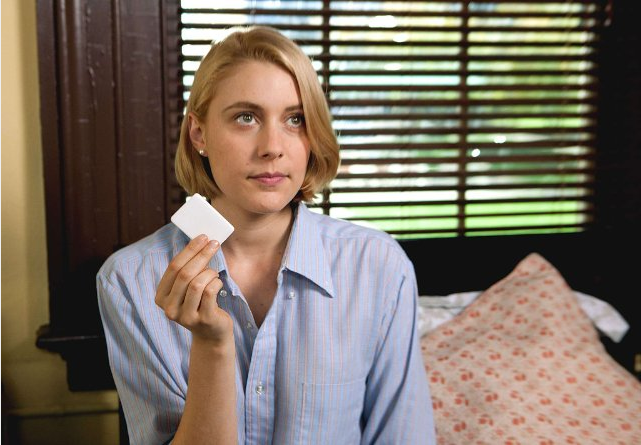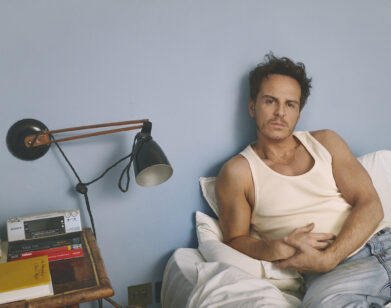Greta Gerwig, Violet Femme

ABOVE: GRETA GERWIG IN DAMSELS IN DISTRESS.
With suicide, Fred Astaire, and a magical bar of soap, this is not your average campus comedy. Rather, it’s Damsels in Distress, the newest from film’s premiere chronicler of the upper-crust and overeducated, Whit Stillman. The film takes place at Seven Oaks, a fictitious East Coast college where a clique of young women hope to save the student population from depression, one donut and dance number at a time. Led by Violet (Greta Gerwig), who dreams of starting an international dance craze, the group takes in a new student, Lily (Analeigh Tipton), who slowly changes the dynamic of the group and causes them to unravel.
Interview spoke with Gerwig about the rhythm of the film, movie musicals, and her experience on late-night television.
CRAIG HUBERT: What first struck you about the character of Violet?
GRETA GERWIG: I’m a huge Whit Stillman fan, so I was primed to love the script, and I did love the script. I’d just never read a character like her, male or female, but especially female. There was something about the way she had these incredibly strong opinions but then she was always ready to be wrong and criticized that I found intoxicating. I adored her and I wanted to play her as much as I wanted to play anything, ever.
HUBERT: You said you were a fan of Stillman’s work. Were you nervous stepping into his world? There’s always the Woody Allen syndrome, where actors in his films tend to act like previous incarnations of Woody. I can imagine it would be difficult to fall into saying these lines like characters from Whit’s previous films.
GERWIG: I was terrified of that. I really tried to not rewatch anything as soon as I knew I was going to do it. I tried to find the words in myself and make them my words, and make them belong to me and be embodied by me instead of imitate the good results of another actor doing it really well. I was very much conscious of not wanting to sound like Chris Eigeman or Kate Beckinsale. I didn’t want to do that. I don’t know if I always succeeded, but it was definitely a heartfelt attempt.
HUBERT: Did you rehearse a lot? The dialogue is pretty dense and specific.
GERWIG: The rehearsal was more dance rehearsal. A lot of the rehearsal ended up being done in the minivan on the way to set every morning with all the girls. We would speed our lines and work the scenes because we would know once we got there we wouldn’t have many chances to get it right. So I think it was definitely something we took upon ourselves.
HUBERT: I guess this is true of all Stillman’s films, but there is a really interesting rhythm, not just in the dialogue of each character, but how the characters bounce off each other.
GERWIG: The rhythm is so built into it, you don’t have to try to have the rhythm, you just do it; by doing it, the rhythm will natural sink into you. It’s like Shakespeare in that way—you don’t have to speak in iambic pentameter, it’s written in iambic pentameter. So if you’re doing it right, and saying the words right, it works, it makes sense that way. So it wasn’t so much conscious as it would just happen, spontaneously, as a result of knowing it and doing it right.
HUBERT: You said you rehearsed the dance sequences, and it seemed like everyone was having a blast doing those.
GERWIG: Yeah, those were the best. [smiles]
HUBERT: Were you working with a choreographer and learning steps?
GERWIG: All the girls were very familiar with dance, but the boys were a bit less so. It was a lot of getting the boys up to speed. But it was sweet; when we weren’t doing anything specific, we’d all be dancing.
HUBERT: Are you a fan of musicals?
GERWIG: I love musicals. I grew up on musicals.
HUBERT: What’s your favorite?
GERWIG: Singin’ in the Rain. All of Sondheim’s musicals I love, but his are more heady. I loved The Sound of Music.
HUBERT: When watching the film, I was thinking of Vincente Minnelli, especially The Band Wagon, though I’m not sure why.
GERWIG: Didn’t Minnelli do Meet Me in St. Louis?
HUBERT: Yeah.
GERWIG: Just the other night I was watching West Side Story, and I was thinking about how people don’t know how to film dance like that anymore. Most of the time when people dance now it’s for music videos, and they don’t ever show the dancer’s full body, and there is so much cutting. There is this one shot—West Side Story, obviously, has the best choreography in the word—with the Jets, the “keep it cool” song. The camera moves with them as they’re moving into a corner, they’re facing away from the camera, and then they turn back to the camera, coming towards it doing the snap. [snaps her fingers] The camera rushes back as they are rushing at it. It’s so exciting. I thought, “I don’t think anyone makes movie musicals like this anymore.” I kind of want to make a movie that is chock-full of dance and shoot tons of it. I saw the Wim Wenders Pina movie, which I liked, but in some ways I would have shot it differently. [laughs] That sounds so arrogant of me to say! I didn’t like it when he took the dancers out into the world; I wanted to see the full dance. Obviously Wim Wenders is great; I’m not shit-talking Wim Wenders. I have very strong feelings about dance and how it’s shot.
HUBERT: I agree, although I heard Pina Bausch wanted it that way.
GERWIG: Well she’s wrong. [laughs]
HUBERT: I agree, I think it hurt the film.
GERWIG: I think that’s the great triumph of those Fred Astaire RKO films, Ruby Keeler, all of that. They really shot those dancers just dancing. When they had one hundred chorus boys, they shot one hundred chorus boys. They really had a lot of great dancers at that time and they let them do their thing. They built these amazing soundstages just for that purpose. I think that’s the way to do it, but I’m not the head of MGM in 1938. [laughs]
HUBERT: Are you interested in directing films?
GERWIG: Yeah.
HUBERT: So we should expect a musical?
GERWIG: Definitely. [laughs]
HUBERT: So is it all big blockbusters in the future? Big musicals, maybe an action film in there?
GERWIG: Totally. I would love to. I don’t know that big movies would love to have me. [laughs] I’m far too middle-class to morally object to a paying job.
HUBERT: By the way, I saw you on television the other night, on a talk show, though I can’t remember which one right now.
GERWIG: Oh, it was Jimmy Fallon.
HUBERT: Right, with Artie Lange. I was thinking you two should be in a comedy.
GERWIG: He was very surprised, because I made a joke at the end [of the segment]. It took him a second, and he was like, “Oh, you made a funny.” I was very proud of that moment. Then when the lights went down, they were both like, “You had the line of the night!” [laughs]
HUBERT: I still think a buddy comedy with you and Artie Lange would be great.
GERWIG: A rom-com with Artie Lange!
DAMSELS IN DISTRESS IS OUT TODAY.






